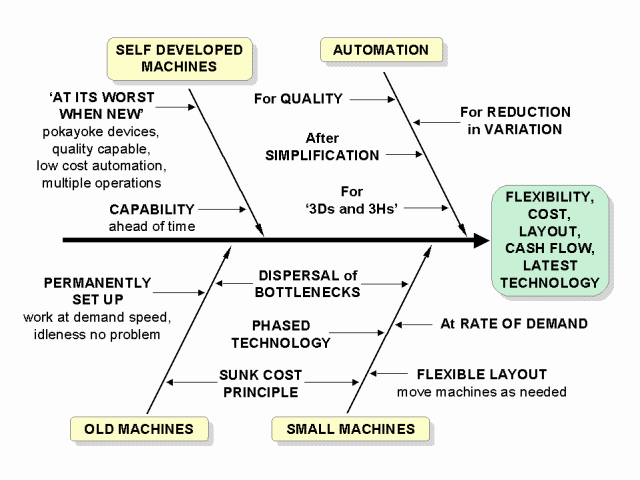
Lean and SMALL MACHINES

The small machine concept is one of the least recognised Lean facilitators. The general principle is to use the smallest machine possible consistent with quality requirements. Several smaller machines instead of one bigger, faster one allows flexibility in layouts, easier scheduling, reduction in material handling, less vulnerability to breakdown, less vulnerability to bottleneck problems, possibly reduced cost (through a mix of capability), and through phasing of machine acquisistion, improved cash flow and more frequent technology updates.
The related sunk cost principle means that the priority should be with minimising present and future costs, not with keeping machines working to 'pay off' a cost which has already been incurred. Therefore utilisation is irrelevant unless it is a capacity constrained machine.
In fact, maximising utilisation is counterproductive - something we learn from statistical thinking and from highway congestion where progress stalls when utilisation gets too high. The reduction in variation in machine cycles is as important as cycle time itself.
The small machine concept can be extended to older machines. The best machine may well be an old machine that is quality capable, that is permanently set up, located just where needed, and that is written off in the books so that no-one cares about utilisation. It is throughput and lead-time that count. Beware of scrapping old machines that are still quality capable for machines that are faster.
Why should a machine be "at it's worst when new"? Because it may not yet have had pokayoke devices fitted, may not yet be quality capable, may not yet have had low cost automation devices integrated with it, and may not yet have been integrated for multiple operations. This is especially true if variation has not yet been tackled.
Developing machine capabilities 'ahead of the game' is good policy. You may not have the time when you need it.
The prime reason for automation in Lean is for quality. The principle is not to automate waste, so simplify first. Ask whether a low cost solution is possible, e.g. a gravity feed rather than a robot. Good reasons for automation are where the task is dull, dirty, dangerous and hot, heavy, or hazardous. Another good reason is reduction in variation. A bad reason is to reduce people. Beware, machines don't make improvement suggestions.